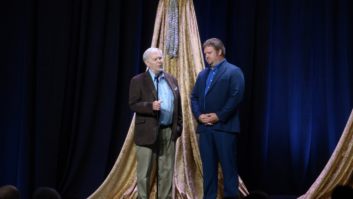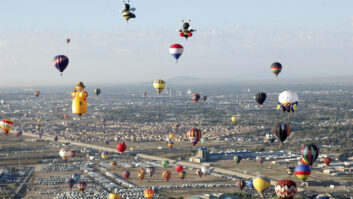Here’s a little troubleshooting quiz for you to think about.

Fig. 1: Wallwarts lined up like soldiers — and identified.
Let’s imagine that the weather has been hot, with record high temperatures; afternoon storms are the rule, not the exception. After one such storm you’re called to a newly built FM site, where the transmitter is showing high VSWR.
You suspect the transmitter but there are no alarms; and readings are close to normal except for reflected power. You can’t verify what the transmitter will do using a dummy load because the site doesn’t have one.
You can’t see the antenna bays because they are covered with radomes. You check the transmission line, figuring it has lost pressure, but then you remember that the line is foam; there is no nitrogen pressure.
Fortunately, the transmitter is not folding back … yet.
The next day, VSWR is a little lower but still there’s nothing obvious. The transmitter is staying on the air, albeit with the high reading, though you’re worried how long it will last. Yet by the end of the week, the VSWR is nearly back to its normal low reading.
Then another storm hits. And the problem repeats.
Do you have ideas of how to fix this? No, I’m not going to make you wait until the next column to reveal the answer. We’ll disclose the answer at the end of the column, so stay awake!
Curt Yengst handles IT for Star 99.1, WAWZ, in Zarephath, N.J. Curt has found another way to put his Brother P-Touch Labeler to good use.
When you are plugging dozens of devices into power strips in the back of an equipment rack, label your plugs and “wallwart” power supplies. This way you can tell at a glance what each plug or supply is powering, thus eliminating guesswork. The extra moments it takes to label things also will eliminate the worry of whether you might take the station off the air if you unplug something. Labeling also ends tedious fumbling in the rack while trying to trace power cords. And it helps too when you should need to relocate the station (as Curt did recently; see radioworld.com, keyword Irene). It’s no fun rummaging through a box of wallwarts trying to figure out which goes to what piece of gear.
Figs. 1 and 2 demonstrate Curt’s efforts.

Fig. 2: Label plugs at the outlet strip to speed troubleshooting and identification.
Curt also suggests including a few extra outlets — or even a short power strip — for plugging in a soldering iron, trouble light or the odd piece of test gear. Adding the extra outlets would prevent anyone from needing to unplug anything in the first place.
(Curt’s suggestion has helped him toward recertification. Snap a few pictures of something you’ve done around your station to make your life easier and email them to me at [email protected]. Remember, published Workbench submissions qualify for SBE recertification credit.)
Back to our VSWR problem.
The giveaway was that the problem recurred with a subsequent storm. You may have guessed lightning; however, rarely does lightning damage to an antenna repair itself.
A tower rigger was dispatched to the top of the tower. When he got there, he saw no weep holes in the radomes — until he looked at the top of the radome clamshell. Yes, the tower crew had installed the radomes upside down.
He drilled a few holes in the bottom radome, unleashing a torrent of water — and curing the problem.
I remember a similar problem at a higher-power installation where the rigger could hear gurgling as he approached the bottom bay. The water actually was boiling inside the bottom half of the radome.
In addition to the VSWR issue, the weight of water inside a radome can generate unwanted “beam-tilt” and possible bend the bay or interbay line. This is serious stuff.
Even if your radomes are installed properly, debris from birds or insects can clog the weep holes. Make sure your rigger checks the holes when inspecting your antenna. The lesson here is to supervise installations at your site regardless of what they are. Know what your contractor is doing and don’t be afraid to speak up.
Contribute to Workbench. You’ll help your fellow engineers and qualify for SBE recertification credit. Send Workbench tips to [email protected]. Fax to (603) 472-4944.
Bisset has spent 43 years in the broadcasting industry and is still learning. He is SBE certified and is a past recipient of the SBE’s Educator of the Year Award. He works for Elenos USA, an FM transmitter company based in Miami.







